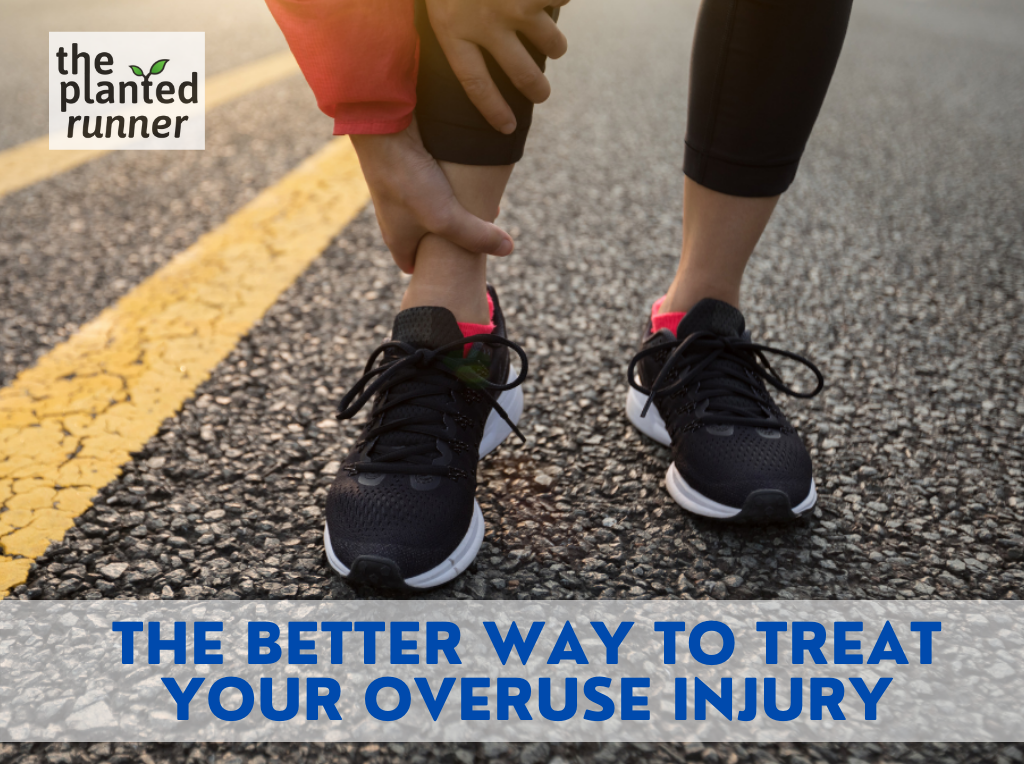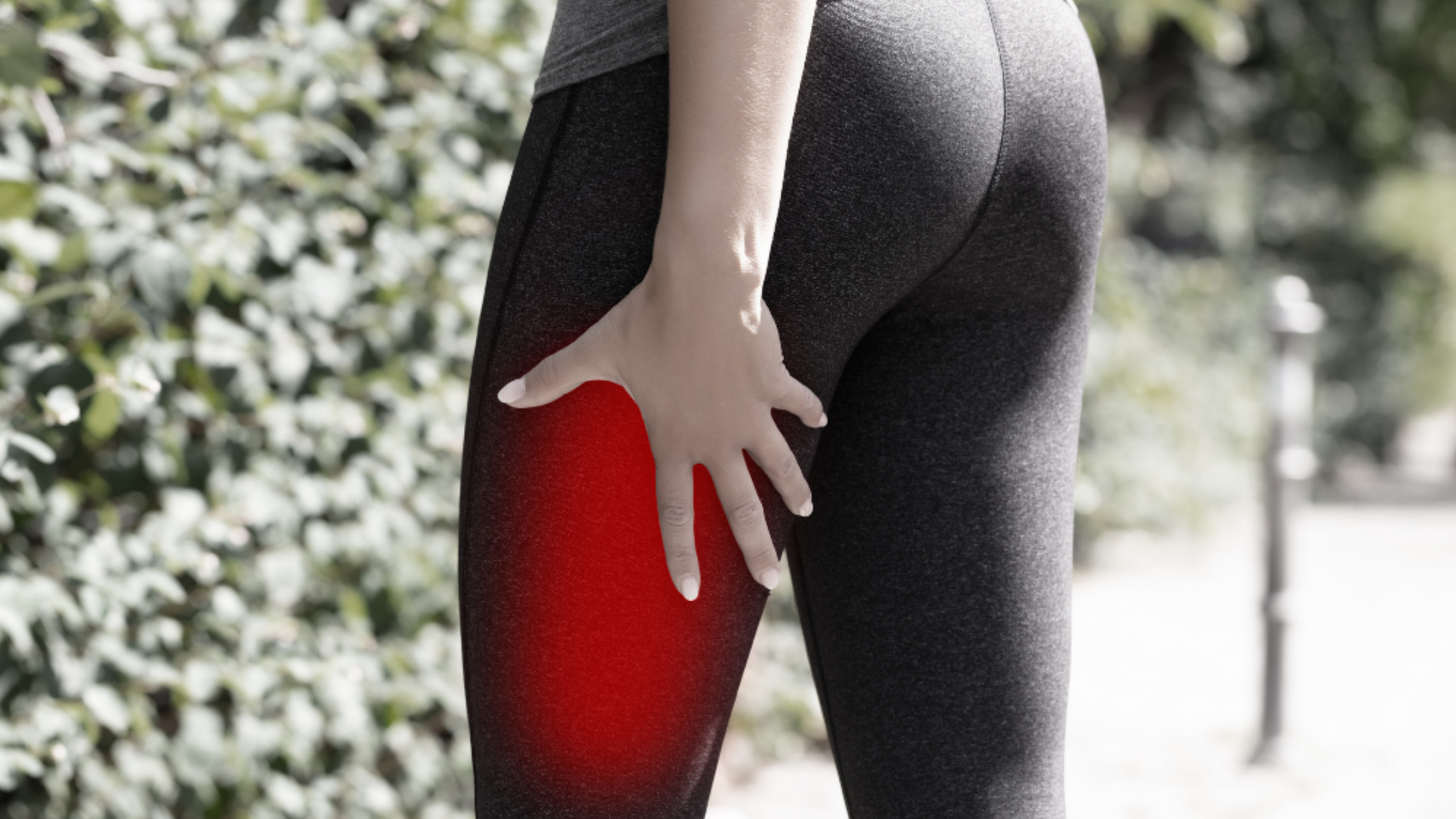The most common treatments for running injuries might actually be slowing your healing. Find out the right way to treat overuse injuries in runners.
It might start as a little twinge. Or a dull ache that grows little by little. Maybe even a stabbing pain surges through the back of your heel forcing you to stop mid run.
Oh no. You are injured.
If you run, there’s a good chance that you’ll get injured sooner or later. Up to 79% of us per year are smacked with some kind of running injury, making the odds of making it through a single year on two healthy feet almost a rarity.
And overuse injuries in runners are often the most common.
So you suck it up, pop an anti-inflammatory, prop your foot up on a bag of frozen peas and settle in for a week-long Netflix binge session.
But you might not be doing yourself any good.
In fact, ice, NSAIDs and rest could actually make your injury heal slower.
Wait, what?
There is a better way.

RICE Can Make it Worse
The common response to any soft tissue injury is the classic RICE treatment that we all learned in basic First Aid. RICE stands for Rest, Ice, Compression, and Elevation and, along with taking an anti-inflammatory pill for pain and swelling, it’s prescribed for every common ailment that running can throw at us from acute ankle sprains to achilles tendonitis to hamstring pulls.
Except in many cases it’s the opposite of what you want to do.
The first step is to determine what type of injury you have before grabbing the Advil and the remote control.
Acute Vs Overuse Injuries
There are two types of running injuries: acute and overuse. When you trip and twist your ankle, that’s an acute injury and you are likely to see a lot of swelling. Immediate icing has been shown in research to dramatically improve sudden inflammatory response but that’s not necessarily a bad thing.
Inflammation is how our bodies heal and restricting that isn’t the way to go.
On the other hand, ice can be helpful as a pain-management tool, with the understanding that it does slow the healing process.
Overuse injuries can heal when you continue to run and can be completely cured when you micro-damage the tendons and muscles even more.
Sounds crazy, right?
Not only should you run and strength train through this type of injury, but ice and NSAIDs should be avoided.
This sounds completely backwards, but the research backs it up.
Inflammation (Or Lack of) Is Key
Let’s look at the achilles to explain. For overuse injuries in runners of the achilles tendon, most people commonly refer to it as achilles tendonitis. The “itis” suffix refers to inflammation.
But that’s actually a misnomer.
“Inflammation of the achilles tendon or its surrounding tissues is not a common finding in athletes with overuse injuries to the achilles,” says John Davis, biomechanics researcher for Runners Connect. “Rather, their pain is caused by real, physical damage to and degradation of the small fibers that make up the achilles tendon. Because of this, some doctors and researchers advocate renaming the injury “achilles tendonosis” or “achilles tendinopathy” to make it clear that degeneration of the tendon fibers is the root of the problem.”
Ice and NSAIDs like Advil work to limit inflammation. If that’s not happening, they won’t help much. In fact, there is evidence that they might make your problem worse by slowing healing.
How Overuse Injuries Heal
What has been proven to heal your heel is eccentric heel drops, an exercise where you slowly lower one heel off a step, then use both feet to raise back up. Eccentrically loading the the calves ends up strengthening the tendon and actually curing the degeneration. Ten to fifteen repetitions twice a day for 12 weeks has been shown to be effective.
Once you get good at that, throw a weight in a backpack and try them! Eccentric heel drops while wearing a weighted backpack can further strengthen the tendon so much that the pain disappears completely.

Should You Run Through Pain?
As a coach, I’m always careful about cautioning my athletes to not run through pain.
A little pain, however, is okay as long as it’s not sharp or increasing as you run. In fact, continuing to train might not make the overuse injury worse, and you may be able heal your injury without sacrificing your fitness.
On the other hand, running through an acute injury or a stress fracture is NOT a good idea and that could most certainly make the injury worse.
Active Recovery
A fascinating study on the achilles showed that a group of runners who continued to through moderate pain (rated as no higher than a 5/10 on a scale of 1 to 10), had the same positive outcomes as the control group who were only allowed “active recovery” activities such as swimming and walking. The running group was not allowed to continue to run if the pain worsened or remained throughout the next day, but as long as their pain stayed moderate and improved instead of regressed, they were allowed to run and healed just as well as the non-runners.
The key words here are moderate and improving, so I’m not saying that it’s a good idea just to push through pain until your tendon ruptures. That’s just silly. But you may not have to be perfectly pain-free to still be able to go out for a run.
When to See a Specialist
Of course, I want to make it clear that I am not a doctor or a physical therapist. If you are in pain and running just hurts, please be smart and go see one of them for advice. Preferably, find a professional that is a runner and understands the obsessed runner’s brain to give you the best diagnosis and treatment plan that will help you get healthy and back to running happy.
What makes sense for you is highly individual, but it’s refreshing to know that every minor niggle doesn’t have to banish you to the couch.
And you can save that bag of frozen peas for dinner.
When you are ready to transform your running and finally reach your true potential, click the button below. Find out how you can truly optimize your running, nutrition, and mindset!

